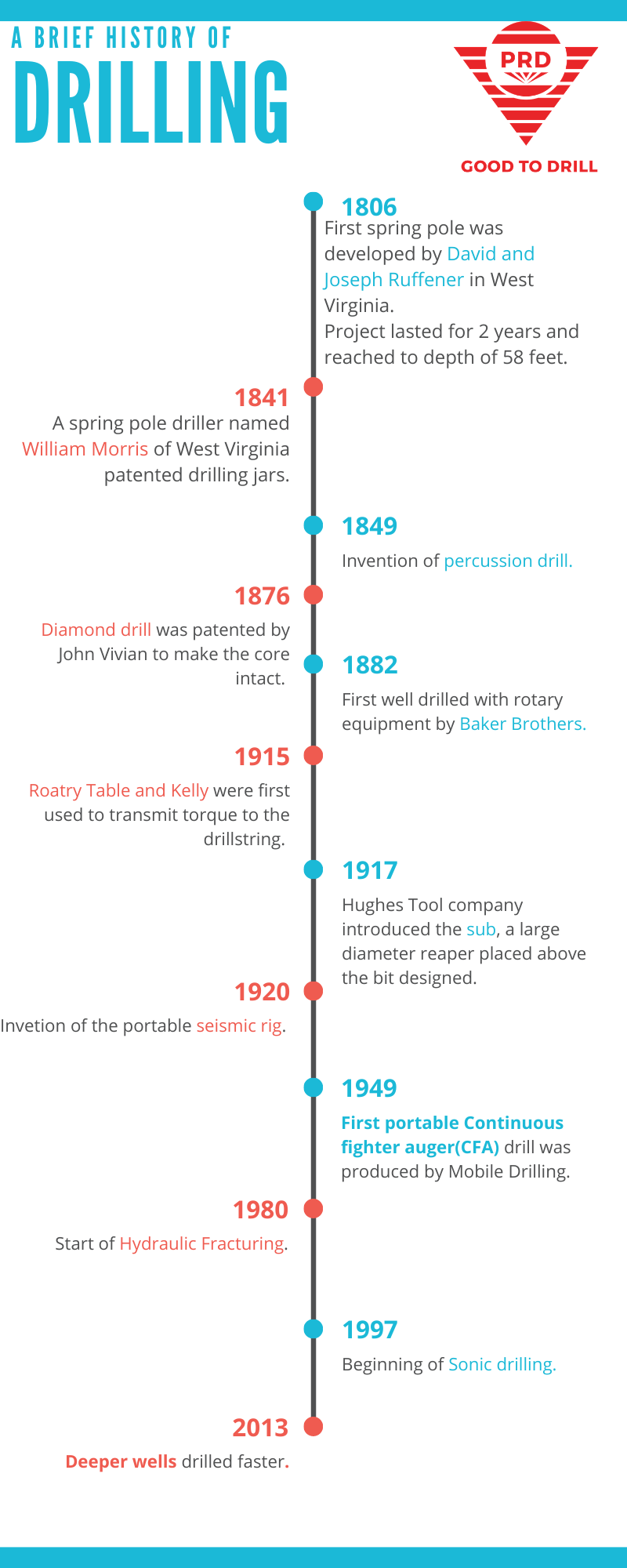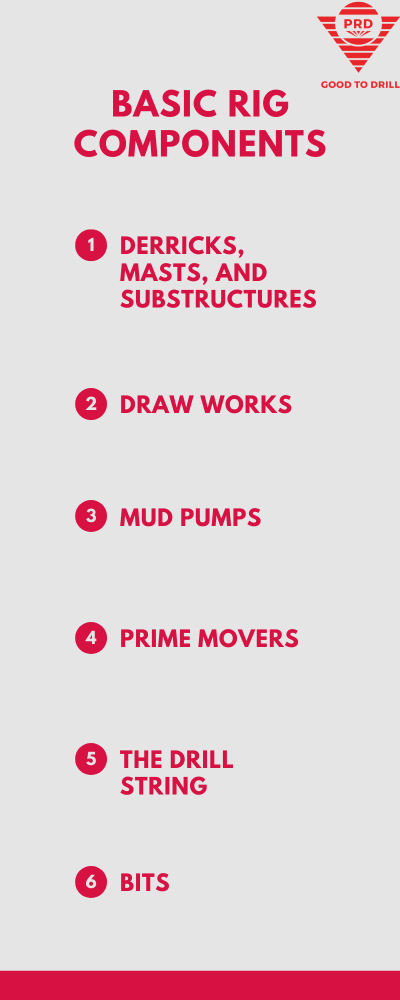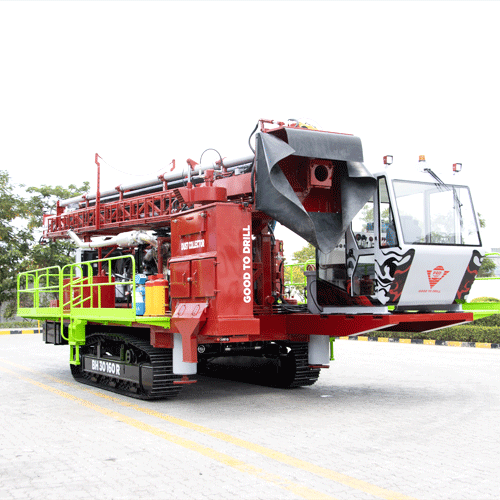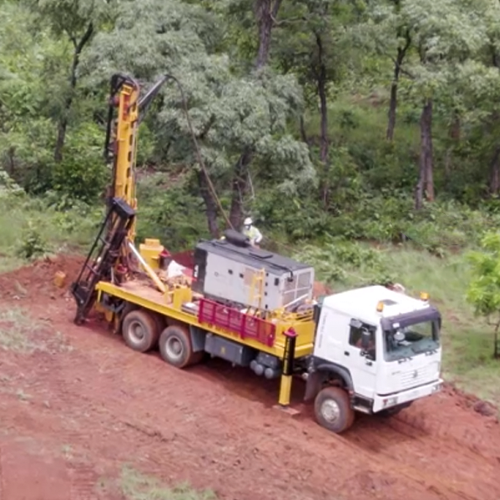Top Factors and Absolute Guide for Rotary Drilling
In this blog, we will talk about the following:-
- What is Rotary Drilling?
- History and Current Technologies of Rotary Drilling.
- General Rotary Drilling Methods.
- Types of equipment and Rotary Drilling components.
- Advantages of Rotary Drilling Rig.
What is Rotary Drilling:
Rotary Drilling refers to the use of sharp, rotating drill bit to cut or crush by applying downward pressure. It is mostly used to drill big holes in pit mines, petroleum extraction and other various fields. To gather information about coal deposits drilling is the most trusted and reliable method. Before drilling, coal prospecting is done to discover coal resources through search.
- Rotary drilling is a general method in drilling in which a string of drill pipe is hung from a derrick and turned by the engine.
- Rotary cutting is also used to drill small boreholes in soft rocks.
- For medium to hard rocks, rotary crushing is used.
- Ai rotary drilling is used to drill deep boreholes in rock formations.
One of the crucial factors with the drilling program is to do selection between core drilling and rotary drilling.

Current Technologies and Innovations:
- New technologies have reduced the environmental impact of energy production by allowing more oil and gas.
- Discovery of new resources plays a crucial role in meeting global energy demand.
- Technological Advancements are used for well drilling and completion have enabled energy industry to reach new sources of oil and natural gas.
- Companies can push length in excess of 3,000 meters as compared to 30 meters a few decades back.
- Horizontal drilling is a directional drilling process which provides more contact to reservoir formation than a vertical well and allows an increase in the production of hydrocarbons.
- When oil and natural gas are in separated layers, multilateral drilling allows to branch out from main well to tap reserves.
- When vertical well cannot be drilled, Extended reach drilling allows producers to reach deposits that are great distances away from a drilling rig.
General Rotary Drilling Methods:
Drilling method varies from digging with tools to high-speed drilling with types of equipment. Small to medium-sized drilling rigs are mobile, such as those used in mineral exploration drilling, blast-hole, water wells. Larger rigs can drill thousands of meters of Earth crust, using large “mud-pumps” to circulate drilling mud through the drill bit.
Importance of Air Compressors and Understanding Geologic Formations in Rotary Drilling
When selecting between mud rotary and air rotary drilling methods, understanding the geologic formations of your site is critical. Different formations, such as unconsolidated sands or hard rock layers, significantly impact your choice of equipment and technique.
For air rotary drilling, an air compressor is a key component. It delivers high-pressure air to power the drill and remove cuttings efficiently from the borehole. This method is especially effective in stable rock formations where the use of fluids can be minimized. By contrast, mud rotary drilling uses drilling fluid to support the borehole walls and carry cuttings to the surface, making it ideal for softer or unstable ground.
Selecting the right method involves analyzing site-specific geologic formations and ensuring the drilling rig is properly equipped — including a reliable air compressor for air rotary applications.
Air Rotary:
- To drill deep boreholes in rock formations, air drilling is used.
- Circulating air is used in this method to cool drill bits.
- By rapid rotation of the drill bit, borehole advancement is achieved.
- Several variations in air rotary techniques includes air rotary casing hammer(ARCH), down hole hammer and under reaming.
- In ARCH, often called “top drive”, both rotational downforce and impact force are provided by an above-hole impact hammer and a rotating drill head.
- Under reaming is a variation of the top drive casing advancer method that uses a rotating cutting bit in front of the advancing casing.
Mud Rotary:
- Drill bit cuts the formation into small pieces, called cuttings.
- These cuttings are removed by pumping drilling fluid through drill pipe called mud.
- The drilling fluid is also used to cool the drill bit and stabilize the borehole wall, prevent fluid loss into the formation.
- Mud rotary is often used in soft sediments that may or may not be saturated with groundwater.
Dual Rotary:
- Unlike other drill rigs which use only an upper drive, dual rotary uses both an upper and a lower head drive to advance the drill bit and casing.
- Dual rotary technology delivers powerful performance in unconsolidated overburden (sand, gravel, cobbles, and boulders) where other technologies struggle to drill a cased hole.
- A top drive rotary head simultaneously handles a drill string equipped with either a down hole hammer, drag bit or rolling cone bit to drill the centre.
Reverse Circulation:
- In reverse circulation, rotational and impact energy are delivered in the same manner as direct air rotary.
- Samples are obtained when high pressure compressed air is injected down the annular space.
- Samples of the substrate from the reverse circulation method are often thought to be more correlative to the depth of the bit face and are favoured in mineral exploration.

Components of Rotary Drilling System:
Actual mechanics of modern rigs are quite complicated while concept of rotary drilling-using a sharp, spinning drill bit to delve into rock is quite simple.
Basic Rotary Drilling system consists of 4 groups of components:-
Prime Movers
- Prime movers are also known as power system of a rotary drilling rig as they provide power to the entire rig.
- When drill rigs were started, steam engines were used to provide power. Use of diesel and gas engines was common post World War II.
- Natural gas is also commonly used to generate electricity and power rig on site.
Hoisting Equipment:
- Hoisting Equipment is made up of tools which are used to raise and lower when equipment go into or come out of the well.
- To support cables and pulleys, derrick is used which is also known as the most visible part of hoisting equipment.
- In deep wells, the combined weight of the drill pipe, drill bit and drill collars may be more than over thousands of pounds.
Rotating Equipment:
- Rotating Equipment is responsible for transferring power from the prime mover to drill bit.
- Swivel a freely rotating equipment carries the entire weight of drill string which is attached to hoisting equipment.
- Below the drill pipe is the drill collars which can be altered depending on down-hole condition experienced while drilling.
Circulating System:
- Three important objectives of the circulating system are cooling and lubricating the drill bit, removing debris and cuttings and coating the walls of well with mud type cake.
- Drilling fluid is circulated down through well hole throughout the drilling process.
- Circulating system consists of drilling fluid pumps, compressors, speciality injectors and plumbing fixtures.
Advantages of Rotary Drilling Rig:
- Lightweight modular design allows greater operational flexibility and makes the rigs easy to install and relocate.
- Drilling rigs are hydraulic with self- propelled and also equipped with computer operating systems.
- According to strata drilling, bits are configured, working in clay soil requires long drilling tube while short drilling tube is suitable for strata containing sand and cobble.
- Better penetration rate and high operational efficiency is achieved by the use of drilling muds which controls downhole pressure, stabilize the hole well, remove drill cuttings and lubricates the drilling bit.
- Rotary drilling rig is considered eco-friendly because of smaller vibrations and less-operating noise.






